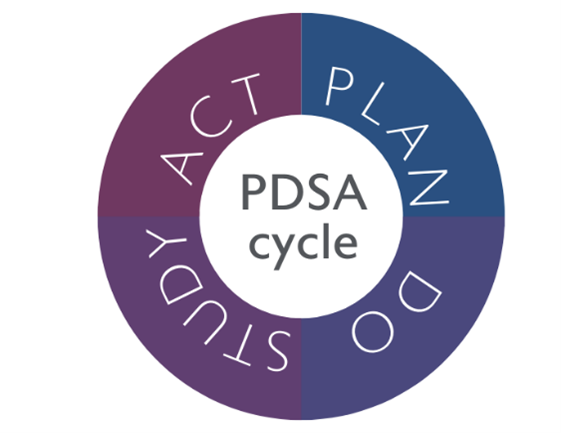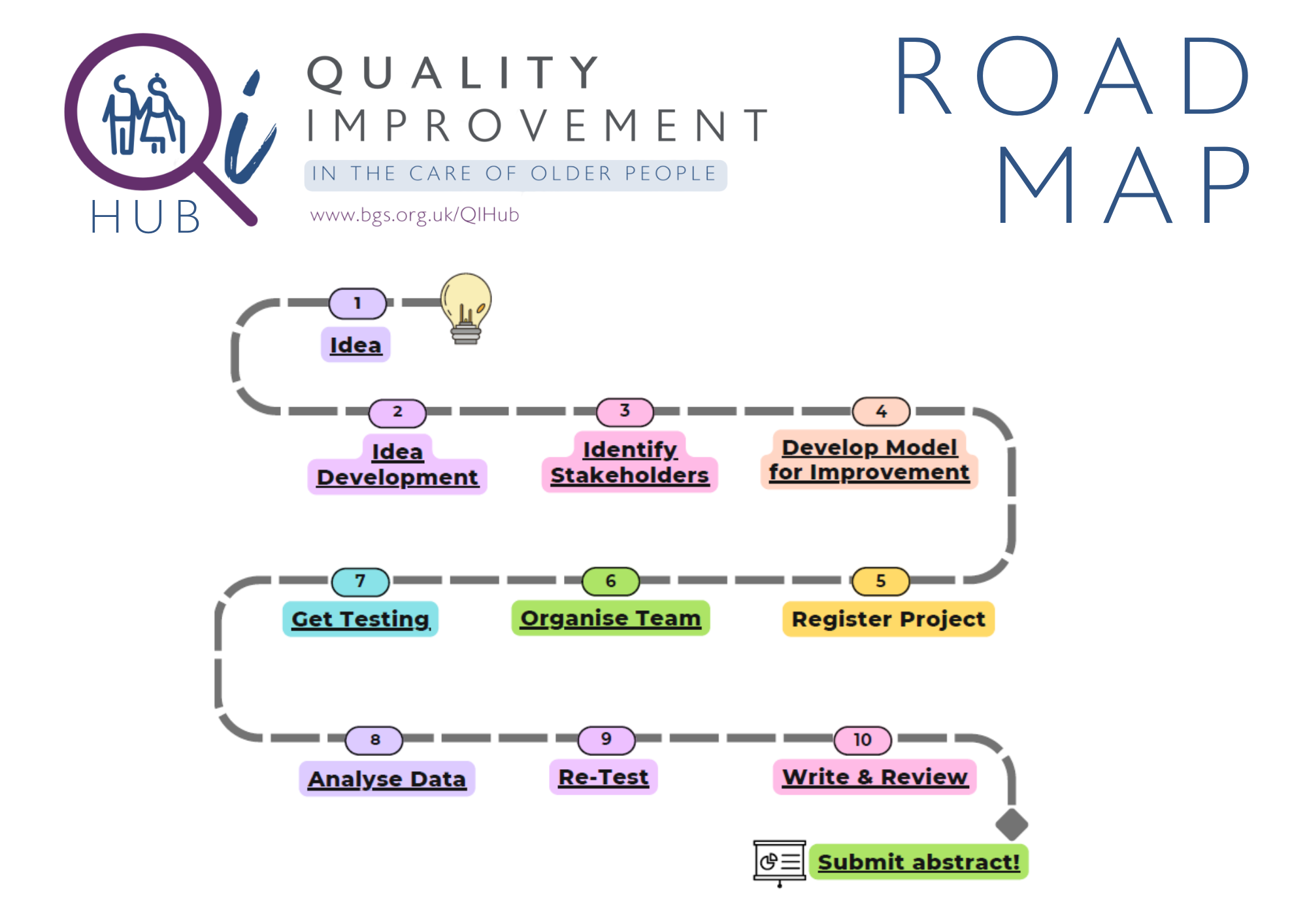QI Hub: Methodology
There are several tools and methods described in the Quality Improvement (QI) literature and it is important you choose the correct one for your project.
To learn more about QI tools and methods, when one might be more appropriate than the other, and their pros and cons, the websites below provide advice and guidance:
- A Guide to Quality Improvement Tools – HQIP
Healthcare Quality Improvement Partnership’s guide introduces a variety of quality improvement tools used in healthcare and presents case examples and associated tools available to assist with implementation. Also includes an e-learning site with certificate on completion.
-
Royal College of Emergency Medicine (RCEM) provide a practical guide for clinicians undertaking quality improvement projects. It introduces the different tools and specifies: when to use it, how to use it, advantages and disadvantages along with examples.
Model for improvement
This simple yet powerful model has been widely taught within the NHS. It underpins many of the QI change projects undertaken within the service and most of the poster presentations seen at BGS conferences.
This section will focus on the model for improvement as a method to drive improvement. It is more responsive than the traditional audit and allows a series of interventions to be tested, adapted and evaluated quickly, making it an effective way to influence culture and create change.
The following links provide a good starting point to find out more about this model:
-
The Improvement Guide: a practical approach to enhancing organizational performance - Langley G, et al. (2nd Edition) 2009
This book explains how the Model for Improvement works in improvement efforts at multinational companies as well as in different industries such as healthcare and public agencies.
-
Quality Improvement - Imperial College Healthcare NHS Trust
These videos explain in more depth how the Model for Improvement can be leveraged.
-
Testing changes: Quality Improvement Zone - TURAS (NHS Education for Scotland)
Animation giving an overview of Testing Changes.
-
Quality Improvement Resources - RCEM
This page collates some of the most useful quality improvement resources for emergency staff.
The Model for Improvement requires us to ask three important questions before anything is done:
1. What are we trying to achieve?
Developing an ‘aim’ statement
Aim setting is important and vital to the success of your project. Be prepared to work hard on this with your team. The aim must be measurable, clear and it must be understood by everyone involved in the project. The aim should be time-specific and it should also define the specific population of people, whether they be patients, staff or others, that will be benefitted by the improvement.
You may not get your aim statement right first time, but it is crucial not to start work on your project until you have a clear and measurable aim.
The below resources may be helpful in defining and refining an aim for your project:
- Setting Aims: Science of Improvement - IHI - (Institute for Healthcare Improvement)
Improvement requires setting aims. An organisation will not improve without a clear and firm intention to do so. Agreeing on the aim is crucial; so is allocating the people and resources necessary to accomplish the aim. This links provides helpful background, the 6 major quality improvement areas, and examples of effective aim statements.
- Tips for Setting Aims: Science of Improvement - IHI (Institute for Healthcare Improvement)
This link summarises five top tips for setting a project aim.
2. How will we know that a change is an improvement?
Developing aims and measures
Planning data collection
- Using data for improvement - BMJ (2019)
Really good article which talks about the role of qualitative and quantitative data for improvement, and how different types of data are needed based on what you’re measuring (outcome measures, process measures, balancing measures, etc).
- Making Data Count - NHS Improvement
This practical guide is suitable for those working at all levels in the NHS, from ward to board, and will show you how to make better use of your data
- The How-to Guide for Measurement for Improvement – NHS Improvement
This guide was designed to help to demonstrate if changes are really improvement, by testing changes and measuring the impact successfully. Part 1 explains what measurement for improvement is and how it differs from other sorts of measurement. Part 2 describes the process of collecting, analysing and reviewing data.
Run charts
- A Guide to Creating and Interpreting Run and Control Charts Turning Data into Information for Improvement - NHS Institute for Innovation and Improvement
A clear guide to analysis run charts. It provides guidance to ask the right questions and to better assess whether a change has led to an improvement.
- Run charts: Quality Improvement – NHS East London Foundation Trust
Step-by-step guide on how to make a run chart.
- Run Chart Part 2: Interpretation of Run Chart Data – Clinical Excellence Commission (Australia)
Australian (NSW Government) video on interpreting a run chart (17 mins in length).
Statistical process control/control charts
- How to use Statistical Process Control (SPC) charts: Quality Improvement - East London NHS Foundation Trust
Useful slides on how to use SPC charts
Different measures
- STEP 3: Process, outcome and balancing measures – East Lancashire Hospitals NHS Trust
One-slide definitions.
3. What changes can we make which will achieve our aim?
Selecting your tests of change
While not all changes lead to improvement, all improvement requires change. The ability to develop, test, and implement changes is essential for any individual, group, or organisation that wants to continuously improve.
Identifying changes to test is often the easiest part of an improvement project. Everyone will have ideas, but how do you choose the right ones and how can you structure your choices so that you are more confident the changes you test are the ones most likely to deliver the aim you wish to see?
- Science of Improvement: Selecting Changes - Institute for Healthcare Improvement (IHI)
Provides examples of change concepts.
Plan, study, do, act: The PDSA cycle
Plan
The first step is to plan your test of change and set your objectives with regards to what you are trying to achieve.
- Improvement Toolkit – AHSN
The Academic Health Science Network have devised the perfect toolkit to get you started with planning your test of change.
- Principles for Tests of Change – TCAB Toolkit
This page talks about the steps you should take prior to implementing a test of change. Outline, what will be done, where will it occur, how the test will run and what the expected outcome will be.
- Prioritisation Matrix – NHS Scotland
The prioritisation matrix is a structure visual tool to help you decide which improvement ideas to test first and how to focus your activity and energy.
- Project Initiation Document – NHS QSIR
NHS QISR’s Project Initiation Document allows you to plan your test of change by prompting you to write down your project rationale, scope, exclusions, constraints, assumptions, objectives, benefits, project approach, planned changes, risks and timescales.
- Project Planning Form – IHI
Institute for Healthcare Improvement have created a more succinct template that healthcare workers can use to plan their project. You need to register for a (free) account to access.
Do
Once you have planned your test for change the next step in the improvement journey is to carry out the test of change and begin data collection. Any change(s) should be tested on a small scale first. The cumulative result of multiple small-scale changes, each tested, learned from and fine-tuned, should result in a measurable and reliable improvement.
- How to Implement Change in Practice – Journal of Oncology Practice
In this paper, Dr Gesme and Dr Wiseman discuss how you to create a readiness to change, deal with resisters and implement change.
- Leading change – Nursing Times
In this article, Joanna Kerridge discusses when to implement a pilot project, how to measure success and how to ensure that a project is sustainable.
- PDSA Worksheet – IHI
The Institute for Healthcare Improvement (IHI) have created a worksheet to help you document your test of change. The worksheet provides a lot of prompts making it a handy document for QI beginners and supervisors. You need to register for a (free) account to view.
- Small Scale Rapid Cycle Testing – Network for Improvement & Innovation
This website explains which small scale, rapid cycle testing is an effective way to manage change and how it can be a stepping stone to improvement.
Study
During the study phase of your QI lifecycle, you are meant to analyse your data, compare data to predictions and summarise your learnings. We have collated some resources to help you navigate this.
- Analysing Quality Improvement and Assurance Data – HQIP
The Healthcare Quality Improvement Partnership have set out the basics of statistical data analysis and presentation in this guide. It aims to help those who are new to statistical data analysis and is a good beginner’s guide.
- Model for Measuring Quality Care – NHS QSIR
It is important for QIPs to have outcome, process, structure and balancing measures. Each of these measures has a different purpose in determining whether the quality improvement project has had the desired impact.
- Statistical Process Control – NHS QSIR
Statistical process control (SPC) is an analytical technique widely used in the NHS to understand whether change results in improvement. This site provides an introduction to what statistical process control is.
- Statistical Process Control Tool – NHS
This tool will enable you to record your data and will automatically plot it on an SPC chart.
Act
So now you’ve made a change but what next? PDSA cycles emphasise the need for ongoing review of data and result to allow adaptation and adoption of the project to ensure maximum benefit. Testing the change ensures the project is moving forward.
- Tips on moving forward – IHI
It is important to plan the next test of change and think ahead as well as reflect on previous cycles.
- Linking tests of change – IHI
This article poses thought-provoking questions to consider when testing a change and gives some useful top tips for successful change. There are some examples of how projects can be adapted though testing changes.
- When to adapt, adopt or abandon – Life QI
These blog articles look at measuring the success of your lifecycles and how to evaluate the data gathers to move forward with your next PDSA cycle: - Comparing Quality Improvement and Implementation Science – BMJ
This article published in the BMJ is a more detailed overview of the differences and overlap between quality improvement (QI) and implementation science (IS). It describes the fundamental components of change and has a simple infographic in Figure 1 that describes the common features of both QI and IS.
- Implementing Change – IHI
This link is to a short video about implementing change, for those who want less reading. There is some useful, though-provoking discussion points attached. This could be made into a small group activity.
Understanding the system
This section looks at better understanding a system and the flow across different systems.
- Improving flow along care pathways - The Health Foundation
The Health Foundation has been supporting efforts to improve the flow of patients along care pathways for more than 10 years. This has culminated in a UK-wide programme, the Flow Coaching Academy (FCA), led by the Sheffield Teaching Hospitals NHS Foundation Trust. The programme is based on a co-coaching model combined with elements of improvement science. It aims to support establishing multiple FCAs across the UK, to scale up the approach and to build a community of practice to share learning. The training focuses on both the technical and relationship skills required to deliver continuous and sustainable improvement.This learning report is based on the formative FCA evaluation completed in 2019 by RAND Europe and interviews with FCA programme leads during the COVID-19 pandemic.
-
This learning report describes the work undertaken by two NHS trusts as part of the Health Foundation’s Flow Cost Quality programme. It illustrates the problems created by poor flow that the programme was set up to address, and provides practical examples of how focusing on flow can improve quality, use available capacity effectively and save money. The report summarises key lessons from the programme and highlights important challenges for designing services and approaching change by focusing on flow.
- Making change across organisations - (health.org.uk)
This video shows how staff from Sheffield Teaching Hospitals NHS Foundation Trust have combined data and patient stories from across the patient pathway – putting the patient at the centre of services.
- The challenge and potential of whole system flow - The Health Foundation
Whole system flow is the coordination of all systems and resources, across a health and social care economy, to deliver effective, efficient, person-centred care in the right setting at the right time and by the right person. Improving flow is seen by both practice leaders and policymakers as having a crucial role to play in driving up service quality and productivity, as well as improving the experience of care for patients and service users.This report introduces methods that local health and social care leaders can use to improve whole system flow. It also describes steps policymakers and regulators can take to create an environment conducive to change at this scale.
- Understanding integration: how to listen to and learn from people and communities - The King's Fund
Picker and The King’s Fund worked with NHS England and NHS Improvement on how Integrated Care Systems can listen to and learn from people and communities. They have produced a practical guide for partners working in these systems, with ideas on how they might go about this.
- The importance of power, context and agency in improving patient experience through a patient and family centred care approach - Health Res Policy Sys (2020)
This article builds on literature by investigating, with multi-disciplinary clinical teams as well as patients and relatives, what factors help or hinder changes designed to improve patient experience.



